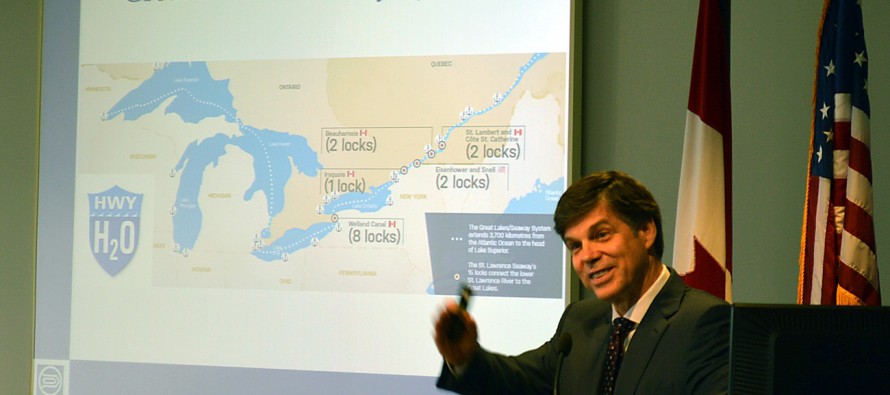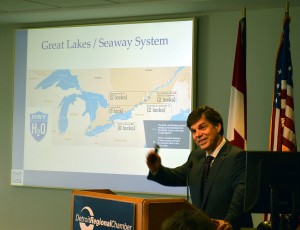Marine shipping on the rebound following 2009 recession


WINDSOR, ON.: President and CEO of the St. Lawrence Seaway Management Corporation Terrence Bowles speaks during a conference held at the office of the Detroit Regional Chamber of Commerce, Oct. 11. (PHOTO By/Richard Riosa)
By Richard Riosa
Businesses folded, purchasing power decreased and many families were left homeless. The global recession of 2009 has had a lasting impact on the economy worldwide. Canada’s recession lasted roughly nine months, starting in late 2008 and ending in 2009. The recession’s impact on Canada was not as large as in the neighbouring U.S.. Although many struggling businesses did fail during this time, there were no massive government bailouts or bank closures on this side of the border.
But Canada’s recession still disrupted the economy, lowered profits and hurt employment rates. According to Statistics Canada, the national income-based GDP decreased by almost five per cent between 2008 and 2009. This decrease in national GDP is reflected heavily in most industries.
The marine shipping industry is crucial to the economy of both the U.S. and Canada. According to Marine Delivers, a bi-national marketing entity, the Great Lakes – St. Lawrence Seaway produces a combined $33.5 billion in economic impact annually for Canada and the U.S. and contributes $4.6 in federal, state/provincial and local taxes each year.
Between 2008 and 2009 the region saw a sharp, 25 per cent decrease in total cargo tonnage coming in and out of the various ports along the Great Lakes – St. Lawrence Seaway. According to president and CEO of the Windsor Port Authority David Cree, the shipping industry responds to the demands of the economy and the demands of production in the region. When the economy suffers, so does the shipping industry.
“We had some fairly significant declines during that period,” said Cree. “We were a little under five million tons coming out of the recession in ’08.”
Terrence Bowles, president and CEO of the St. Lawrence Seaway Management Corporation, said the region’s reliance on manufacturing tends to drive the local economy.
“This whole area’s very heavily manufacturing intensive, which was a negative for a while there, but today people understand that manufacturing has a very important role to play with jobs and everything else,” said Bowles.
President and CEO of The Interlake Steamship Company Mark Barker said his company was also negatively affected by the recession. Interlake Steamship is a U.S.-based company which owns and operates Great Lakes freighters. Barker said the Detroit – Windsor area’s manufacturing industry is important for the survival of the region’s shipping industry.
“2009 was a tough time for all, with the U.S. and the economy,” said Barker. “We (Interlake Steamship) were no different.”
The recession also caused a decrease in cargo shipping at Windsor’s local ports. According to statistics on the port authority’s website, 2009 saw a six per cent decrease in total yearly cargo tonnage from the previous year and a 15 per cent decrease from their 10-year high which occurred just three years prior in 2006.
Cree said the Port Authority’s 12 terminals throughout Windsor handle between five and six million tons of cargo each year. In 2009, according to their website, the port only handled 4.9 million tons of cargo.
Although the recession has negatively affected marine shipping in the region, as well as locally, Cree said the industry is rebounding nicely in recent years.
By 2012 the total amount of cargo tonnage coming in and out of the Great Lakes region has increased more than 27 per cent in the three years since the recession’s lowest point. Barker said although the industry has improved, it has not yet returned to the prosperity it had before the recession.
“We are not back to our pre-recession levels, but autos are doing well, that means steel does well. That means cargo is moving, so all and all I think Great Lakes shipping is doing well,” said Barker.
Windsor’s port also saw an increase of 11 per cent in total tonnage from the end of the recession until 2012. Cree said the port has rebounded tremendously and 2013 is likely to be the best year in the port authority’s history.
“This year we’ll do a little over six million (tons),” said Cree. “We’re having a very good year this year because of what’s happening with the parkway and the huge amount of stone and construction aggregate.”
Cree said he expects 2014’s numbers to be similar to this year’s as the Rt. Hon. Herb Gray Parkway wraps up construction. He said he expects marine shipping to remain a stable and important industry for the region for the foreseeable future.
“We see ourselves leveling off now. We’ve hit a pretty good peak last year, this year and 2014, but we hope it’ll level off in that 5.5 million ton range and that’ll be a good bounce back from the recession.”


